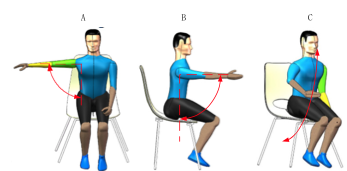The continuous control of rehabilitation robots based on surface electromyography (sEMG) isa natural control strategy that can ensure human safety and ease the discomfort of human-machine coupling.However, current models for estimating movement of the upper limb focus on two dimensions movement,and models of three dimensions movement are too complex. In this paper, a simple-structure temporalinformation-based model for upper limb motion was proposed. An experiment of the multijoint motionof the upper limb was carried out. We studied the touching motion and the compound task motion of theupper limbs. The touch motor task consists of three tasks, namely, shoulder abduction, shoulder forwardbend and finger-nose. The compound tasks include driving and fetching objects. Three-dimensional upperlimb movement data and sEMG signals of seven upper limb muscles were recorded from seven healthysubjects. Model training was carried out after data preprocessing and feature extraction. Then, 120 s of upperlimb motion data was used to verify the performance of the model proposed in this paper. The estimatedaccuracy of the model for the touch tasks was 0.9171, and it was 0.8109 for compound tasks. Compared tothe multilayer perception (MLP) model, a 13.57% reduction in the root-mean-square error (RSME) wasobserved. The results show that the model has good accuracy for estimating the angular motion of theupper limb and that it has the potential to be applied for three-dimensional motion control in an upper limbmirror-image therapy rehabilitation robot.
Presented on 22.01.2020 by Stephan Lehmler
Paper:
https://ieeexplore.ieee.org/stamp/stamp.jsp?tp=&arnumber=8918182

